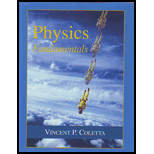
Concept explainers
To Find: The vector sum of all gravitational forces acting on the given system.
Explanation of Solution
Given:
Mass of A,
Mass of B,
Mass of C,
Mass of D,
Distance between A and B,
Distance between B and C,
Distance between A and C,
Distance between C and D,
Distance between B and D,
Formula used:
Gravitational force between two bodies having mass m and M , d distance away is:
G is the gravitational constant.
Calculation:

Distance between A and D,
Gravitational force on A due to B:
Gravitational force on A due to C:
Gravitational force on A due to D:
Gravitational force on B due to C:
Gravitational force on B due to D:
Gravitational force on B due to D:
Thus, the vector sum of all the gravitational forces acting on the system is:
Conclusion:
Thus, the vector sum of all gravitational forces acting on the given system is:
Want to see more full solutions like this?
Chapter 6 Solutions
Physics Fundamentals
- A planet of mass 4.00 1024 kg is at location < -8.00 1011, 2.00 1011, 0 > m. A star of mass 7.00 1030 kg is at location < 5.00 1011, -2.00 1011, 0 > m. What is the force exerted on the planet by the star?arrow_forwardMass M is divided into two parts xM and (1-x)M. For a given separation, the value of x for which the gravitational attraction between the two pieces becomes maximum. Find this maximum value of x.arrow_forward(a) Evaluate the gravitational potential energy between two 5.00-kg spherical steel balls separated by a center-tocenter distance of 15.0 cm. (b) Assuming that they are both initially at rest relative to each other in deep space, use conservation of energy to find how fast will they be traveling upon impact. Each sphere has a radius of 5.10 cm.arrow_forward
- MY NOTES ASK YOUR TEACHER PRACTICE ANOTHER A neutron star has a mass of 1.9 x 1030 kg (about the mass of our sun) and a radius of 6.0 x 103 m (about the height of a good-sized mountain). Suppose an object falls from rest near the surface of such a star. How fast would this object be moving after it had fallen a distance of 0.019 m? (Assume that the gravitational force is constant over the distance of the fall and that the star is not rotating.) 438887.22 X m/s Additional Materials eBook 2,178 ??TOO OCT 21 MacBook Air esc 000 O00 F4 F1 F2 F3arrow_forwardWhat must the separation be between a 5.2 kg particle and a 2.4 kg particle for their gravitational attraction to have a magnitude of 2.3 * 10-12 N?arrow_forward, then a tion 7-36 potential 3. Three identical point masses, each of mass 1 kg lies in the x-y plane at points (0, 0), (0, 0.2 m) and (0.2 m, 0). Find the net gravitational force on the mass at the origin. tion 7-37 It is this ical case: YA B(0, 0.2) FAB (0.2, 0) (0, 0) A FAC Xarrow_forward
- 1) One of the tallest radio towers is in Fargo, North Dakota. The tower is629 m tall, or about 44 percent taller than the Sears Tower in Chicago.If a bird lands on top of the tower, so that the gravitational potentialenergy associated with the bird is 2033 J, what is its mass? Using=EG=MGH formulaarrow_forwardThree spheres, each of radiusR are fixed at 3 points such that their centres form an equilateral triangle of side d. With what velocity should a particle of mass 'm' be projected from the mid-point of one of the sides of the triangle, so that it escapes the gravitational field of the system? Given that the mass of each sphere is M.arrow_forwardThe moon orbits the earth along a path of radius 3.84 x 108 m , a spaceship of mass 30000 Kg orbits the Earth along a path of radius 2.8 x 108 m. calculate: a) The gravitational force exerted on the spaceship when it is at the line joints the centers of the earth and the moon. b) the gravitational field strength of the Earth at a point that locates at the orbit of the spaceship. G = 6.67 x 10-11 Nm2/Kg2 ME = 6 x 1024 Kg , Mm = 7.35 x 1022 Kgarrow_forward
- Evil extraterrestrials crash the moon into Earth. As a result Earth gains 10% mass and moves 10% away from the Sun. What is the ratio of Gravitational force of Earth – Sun System before and after extraterrestrial’s atrocity?arrow_forwardTwo objects attract each other with a gravitational force of magnitude 1.00E-8 N when separated by 20.0 cm. If the total mass of the two objects is 5.00 kg, what is the mass of each? (2kg and 3kg)arrow_forward(2) A particle of mass m is projected vertically upward in a constant gravitational field with initial speed v,. The retarding force is given by F, = v3 pv², The equation of motion is written as:arrow_forward
 College PhysicsPhysicsISBN:9781305952300Author:Raymond A. Serway, Chris VuillePublisher:Cengage Learning
College PhysicsPhysicsISBN:9781305952300Author:Raymond A. Serway, Chris VuillePublisher:Cengage Learning University Physics (14th Edition)PhysicsISBN:9780133969290Author:Hugh D. Young, Roger A. FreedmanPublisher:PEARSON
University Physics (14th Edition)PhysicsISBN:9780133969290Author:Hugh D. Young, Roger A. FreedmanPublisher:PEARSON Introduction To Quantum MechanicsPhysicsISBN:9781107189638Author:Griffiths, David J., Schroeter, Darrell F.Publisher:Cambridge University Press
Introduction To Quantum MechanicsPhysicsISBN:9781107189638Author:Griffiths, David J., Schroeter, Darrell F.Publisher:Cambridge University Press Physics for Scientists and EngineersPhysicsISBN:9781337553278Author:Raymond A. Serway, John W. JewettPublisher:Cengage Learning
Physics for Scientists and EngineersPhysicsISBN:9781337553278Author:Raymond A. Serway, John W. JewettPublisher:Cengage Learning Lecture- Tutorials for Introductory AstronomyPhysicsISBN:9780321820464Author:Edward E. Prather, Tim P. Slater, Jeff P. Adams, Gina BrissendenPublisher:Addison-Wesley
Lecture- Tutorials for Introductory AstronomyPhysicsISBN:9780321820464Author:Edward E. Prather, Tim P. Slater, Jeff P. Adams, Gina BrissendenPublisher:Addison-Wesley College Physics: A Strategic Approach (4th Editio...PhysicsISBN:9780134609034Author:Randall D. Knight (Professor Emeritus), Brian Jones, Stuart FieldPublisher:PEARSON
College Physics: A Strategic Approach (4th Editio...PhysicsISBN:9780134609034Author:Randall D. Knight (Professor Emeritus), Brian Jones, Stuart FieldPublisher:PEARSON





